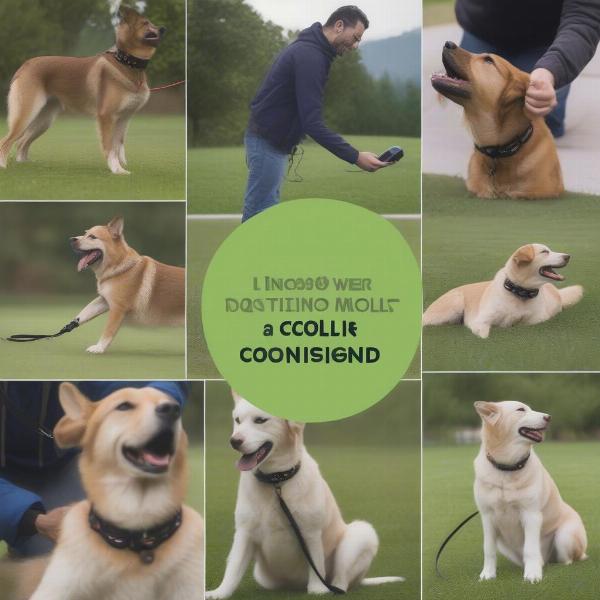A training collar with a remote can be a powerful tool for shaping your dog’s behavior, but it’s essential to choose and use it responsibly. This guide explores the different types of remote training collars, how to choose the right one for your dog, and most importantly, how to use it effectively and humanely for optimal training results. We’ll cover everything from basic obedience to addressing specific behavioral issues, ensuring you have the knowledge to make informed decisions for your furry friend.
Types of Remote Training Collars
Understanding the different types of remote training collars available is crucial for making the right choice. The most common types include:
- Vibration Collars: These collars use vibration as a stimulus, offering a gentle and often effective way to redirect your dog’s attention. They are a good starting point for many dogs, especially those sensitive to other stimuli.
- Shock Collars (e-collars): These collars deliver a static correction, which can be adjusted to varying intensities. While effective, they require careful and responsible use to avoid causing harm or fear. It’s important to note that shock collars are controversial and banned in some countries.
- Ultrasonic Collars: These collars emit a high-pitched sound, inaudible to humans but detectable by dogs. They can be effective for interrupting unwanted behaviors, but their effectiveness can vary depending on the dog’s sensitivity to sound.
- Spray Collars: These collars release a burst of citronella spray, which dogs typically find unpleasant. This can be a humane and effective alternative to shock collars for interrupting unwanted behaviors.
Choosing the Right Training Collar
Selecting the right training collar for your dog depends on several factors, including your dog’s size, temperament, and the specific behaviors you’re addressing.
Consider Your Dog’s Size and Temperament
A smaller dog will require a smaller and less intense collar than a larger breed. Similarly, a sensitive dog may respond better to vibration or ultrasonic collars, while a more stubborn dog may benefit from a shock collar (used responsibly and with proper training).
Identify Your Training Goals
Are you working on basic obedience, recall training, or addressing specific behavioral problems like excessive barking or aggression? Different collars are better suited for different training goals.
Consult with a Professional Dog Trainer
If you’re unsure which collar is right for your dog, consulting with a certified professional dog trainer is always recommended. They can assess your dog’s individual needs and provide guidance on choosing and using a training collar effectively.
Using a Remote Training Collar Effectively
Using a remote training collar effectively requires patience, consistency, and a commitment to positive reinforcement.
Start with the Lowest Setting
Always begin with the lowest setting and gradually increase the intensity only if necessary. The goal is to find the lowest level of stimulation that effectively gets your dog’s attention.
Pair the Collar with Positive Reinforcement
Never use the collar solely for punishment. Always pair the stimulation with positive reinforcement, such as praise or treats, when your dog exhibits the desired behavior.
Be Consistent with Commands
Use clear and consistent commands. Your dog needs to understand what you expect of them. Inconsistency will only confuse them and hinder the training process.
Avoid Overusing the Collar
Overusing the collar can lead to your dog becoming desensitized to the stimulation or developing negative associations with it. Use it sparingly and only when necessary.
 Using a Remote Training Collar Effectively
Using a Remote Training Collar Effectively
Conclusion
A remote training collar can be a valuable tool for dog training when used responsibly and humanely. By understanding the different types of collars, choosing the right one for your dog, and following the guidelines for effective use, you can achieve positive training outcomes and strengthen your bond with your furry companion. Remember, consistency, patience, and positive reinforcement are key to success.
FAQ
- Are remote training collars cruel? When used responsibly and humanely, remote training collars are not cruel. However, misuse can lead to pain and fear. Always prioritize positive reinforcement and use the collar as a tool for communication, not punishment.
- What age can I start using a training collar? It’s generally recommended to wait until your dog is at least six months old before introducing a training collar.
- Can I use a training collar on all breeds? While training collars can be used on most breeds, some breeds are more sensitive than others. Consult with a professional trainer to determine the best approach for your specific breed.
- How long should I use the collar during each training session? Keep training sessions short and focused, typically no longer than 15-20 minutes.
- What if my dog doesn’t respond to the training collar? If your dog doesn’t respond to the collar, consult with a professional trainer. They can help you identify the underlying issue and adjust your training approach.
- Are there any alternatives to training collars? Yes, there are many alternative training methods, such as positive reinforcement training, clicker training, and lure-reward training.
- Where can I find a certified professional dog trainer? You can find certified professional dog trainers through organizations like the Certification Council for Professional Dog Trainers (CCPDT).
ILM Dog is a leading international website dedicated to providing dog owners with reliable and practical information on all aspects of dog care and training. From breed selection and healthcare to nutrition and grooming, we offer expert advice to help you provide the best possible care for your furry companion. Whether you’re a new dog owner or a seasoned pro, ILM Dog is your go-to resource for everything dog-related. Contact us for personalized guidance: Email: [email protected], Phone: +44 20-3965-8624. Visit us at ILM Dog for more expert advice and resources.